
This 1-Ingredient Gluten-Free Buckwheat Bread recipe is an absolute game-changer! I’ve been making it every single week since early 2022, and it never disappoints! It’s incredibly easy, delicious, and super nourishing. I highly recommend throwing a couple of slices in the toaster/oven to create the ultimate avocado toast or as a side dish for dipping into soup. It even makes amazing croutons in a salad!
Since sharing this recipe with our community on social media, it’s become one of our most popular recipes to date. Hundreds of our community members have shared their versions with us on Instagram. Check out our Buckwheat Bread Instagram Highlights to see just a sample of the ones we’ve received, and please make sure to share your own! If you’re in interested in more gluten-free bread recipes, you’ll also love this super fluffy Red Lentil Quinoa Bread!

Ingredient Notes
- Hulled Raw Buckwheat: Buckwheat groats (or kernels) are the hulled seeds of the buckwheat plant. Despite their name containing the word “wheat,” buckwheat is actually gluten-free and makes for a fantastic bread ingredient. These groats are a staple in many Eastern European and Asian cuisines, known for their nutty flavor and versatile use. This Healthy Buckwheat Bread Recipe is a testament to that.
- Water: Tap water is fine to use depending on your location, if the water is heavily chlorinated in your area, you should choose filtered water, as chlorine will impact the fermentation.
- Salt: Either sea salt flakes or table salt works fine. The salt enhances the natural flavor of the buckwheat.
- Poppy and Sesame Seeds: Adds a delightful crunch and visual appeal to the bread. They are optional but highly recommended for an extra touch of flavor and texture. You can top it with any seeds you like.
IMPORTANT: Use ONLY hulled, non-roasted buckwheat for this recipe. Buckwheat flour, unhulled buckwheat, activated buckwheat, or roasted buckwheat will not work in this recipe.
Why You’ll Love This 1-Ingredient Buckwheat Bread Recipe
- Delicious and Dense: It’s absolutely delicious, with a dense, satisfying texture, and gets even better when toasted! Fermentation not only enhances the flavor, but it can improve the bioavailability of certain nutrients in foods. Specifically, the fermentation process can reduce levels of phytic acid, which is known to bind some minerals and reduce their absorption. By breaking down phytic acid, fermentation can make minerals like iron, zinc, and magnesium more available for absorption by the body.
- So Easy: Although the fermentation process takes a bit of time, this recipe is very hands-off and only requires about 10 minutes of actual work. If you use the right kind of buckwheat, a high-speed blender, and follow the instructions, this simple, yeast-free bread recipe is practically foolproof.
- Cost-effective: Good quality, nourishing, gluten-free bread can be quite expensive where we live, often costing around $15 AUD (~ $9.80 USD), whereas this Gluten-Free Buckwheat Bread comes in at under $3.50 AUD (~ $2.30 USD), even when using organic hulled buckwheat.
- Meal-Prep: Easy to prep in advance and can be frozen. I usually keep half fresh, wrapped in a clean kitchen cloth, to consume in the next few days and slice and freeze the rest. Toast when ready to eat, and it’s as good as fresh! This way, you can toast a piece whenever you crave some delicious bread.
What Are the Health Benefits of Buckwheat?
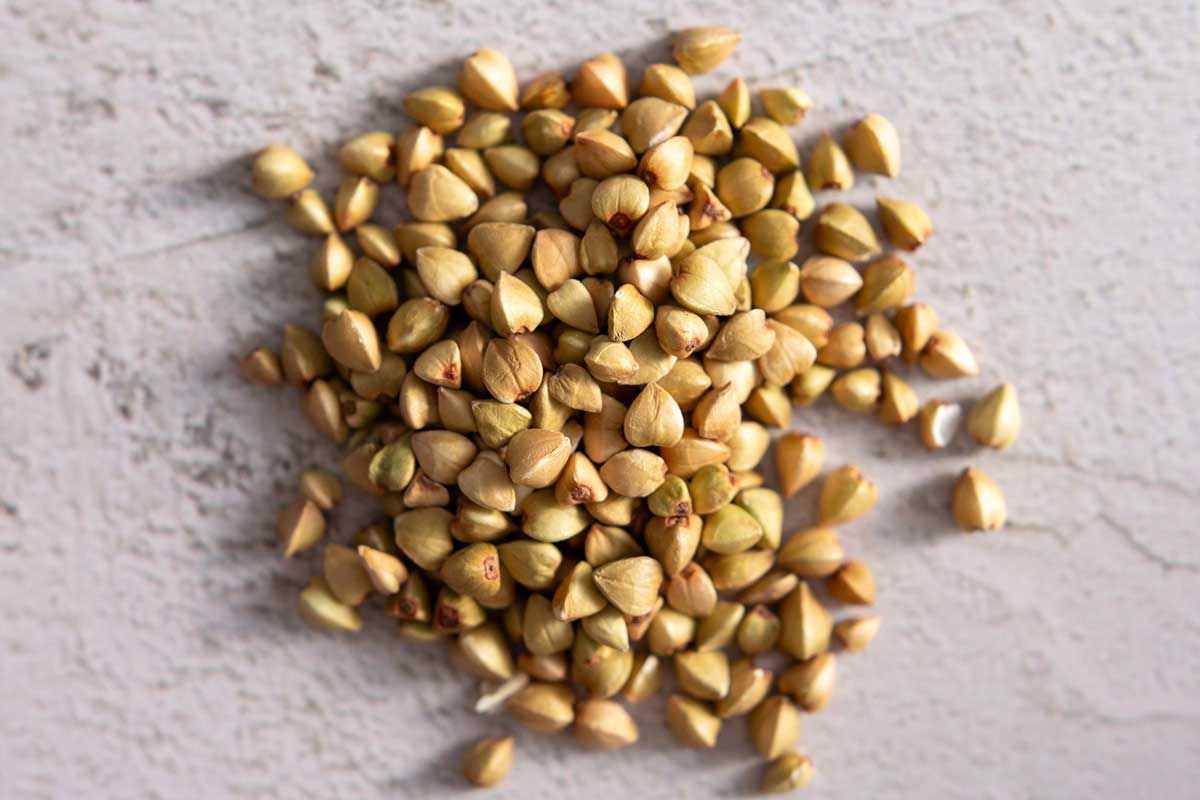
- Buckwheat is highly nutritious, offering a source of fiber and essential minerals, especially magnesium. It’s also packed with antioxidants, particularly rutin, which supports blood vessel health. Despite its name, buckwheat is naturally gluten-free, making it suitable for those with gluten intolerance or celiac disease.
- Buckwheat’s low to medium glycemic index makes it a good choice for those managing blood sugar levels. Plus, its high fiber content aids in digestion.
- Like amaranth or quinoa, these whole grain groats can be cooked like rice or oats, making them a fantastic ingredient for various dishes. From traditional porridge and pilafs to modern salads and even as a rice substitute, buckwheat is incredibly adaptable. It’s also used in making buckwheat flour, a popular alternative for gluten-free baking. We use buckwheat flour to make these High-Protein Buckwheat Pancakes with Blueberry Syrup, and they’re so fluffy and delicious!
Step-by-Step Instructions
Rinse the hulled buckwheat kernels under cold water until clear. After rinsing, soak 17.5 oz (2.6 cups or 500g) of buckwheat in cold water in a large bowl, fully submerged, and cover with a clean cloth for 6 to 7 hours.
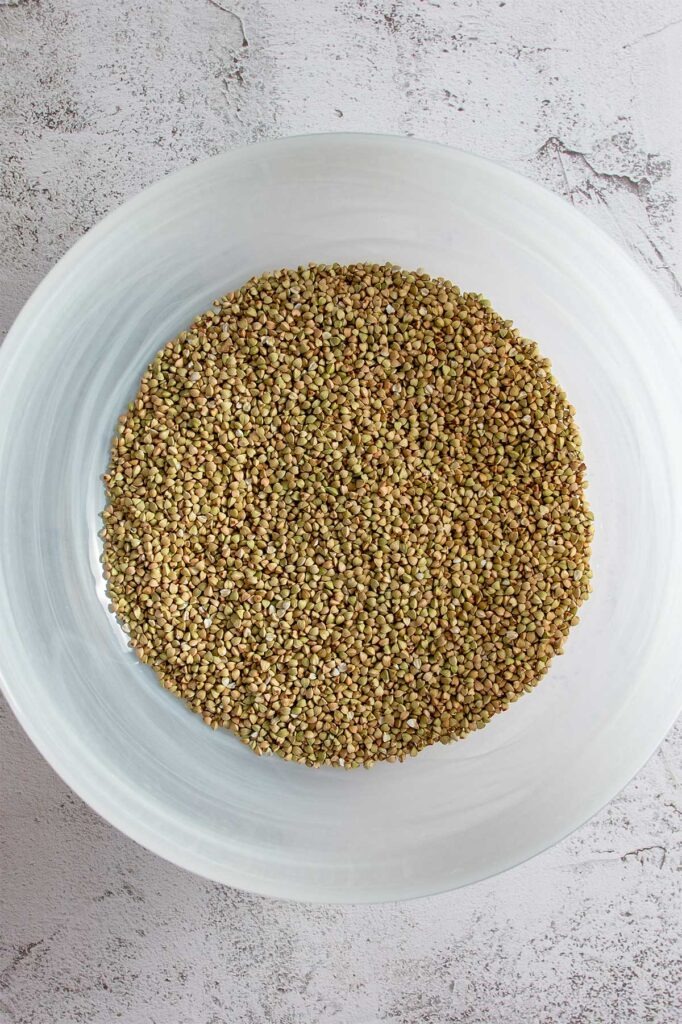

Once soaked, drain the remaining water, but do not rinse.


Transfer to a blender with 6.8 fl oz (0.9 cups or 200 ml) of water and ¼ tsp salt. Blend, starting at low speed and slowly increasing, until you get a very smooth texture without any pieces left. Pour the blended buckwheat mixture back into the bowl.
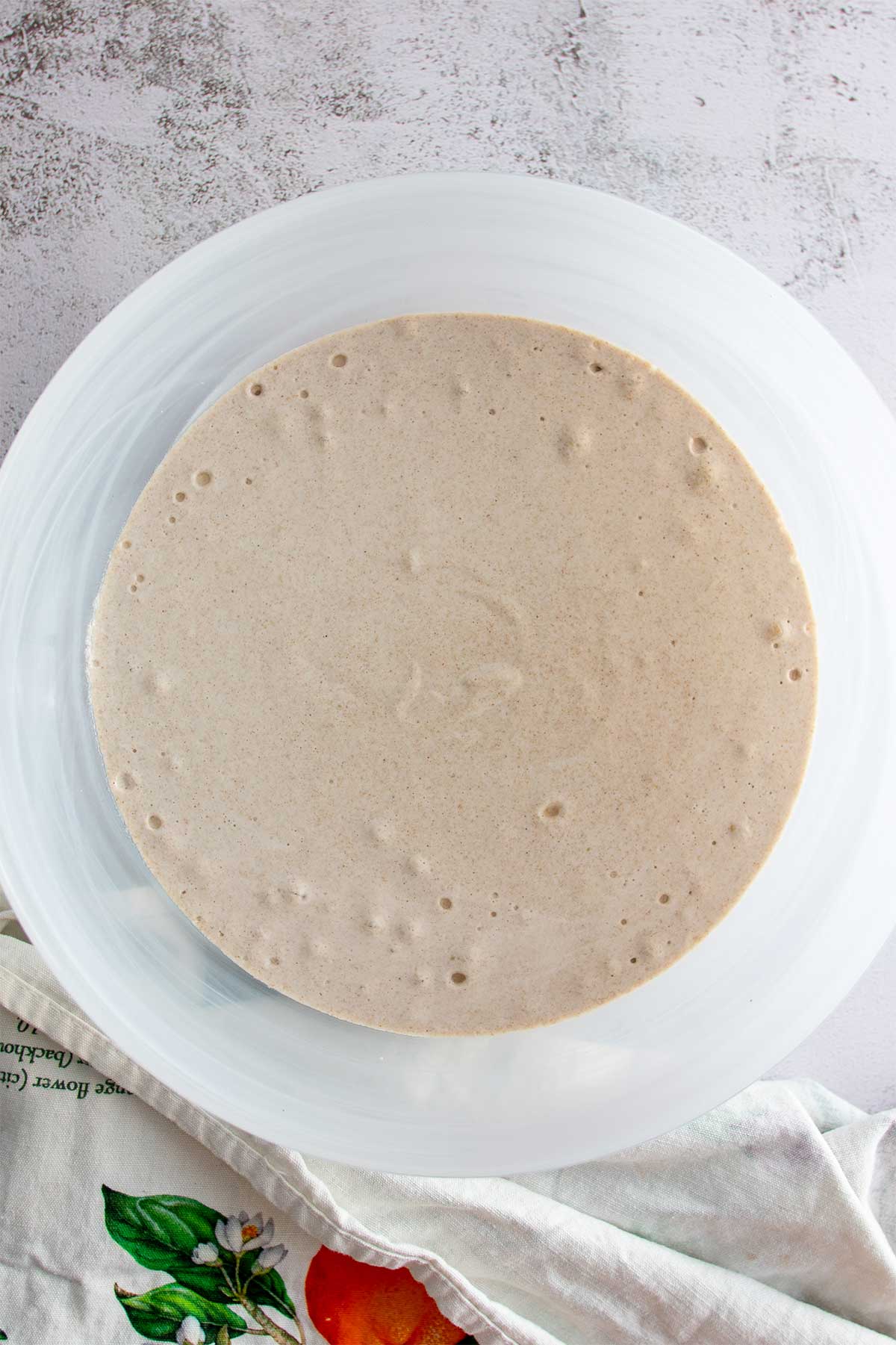
Cover it again and let it sit at room temperature for 12 to 24 hours to ferment. Please check the fermentation table below to confirm the time required based on your current climate.
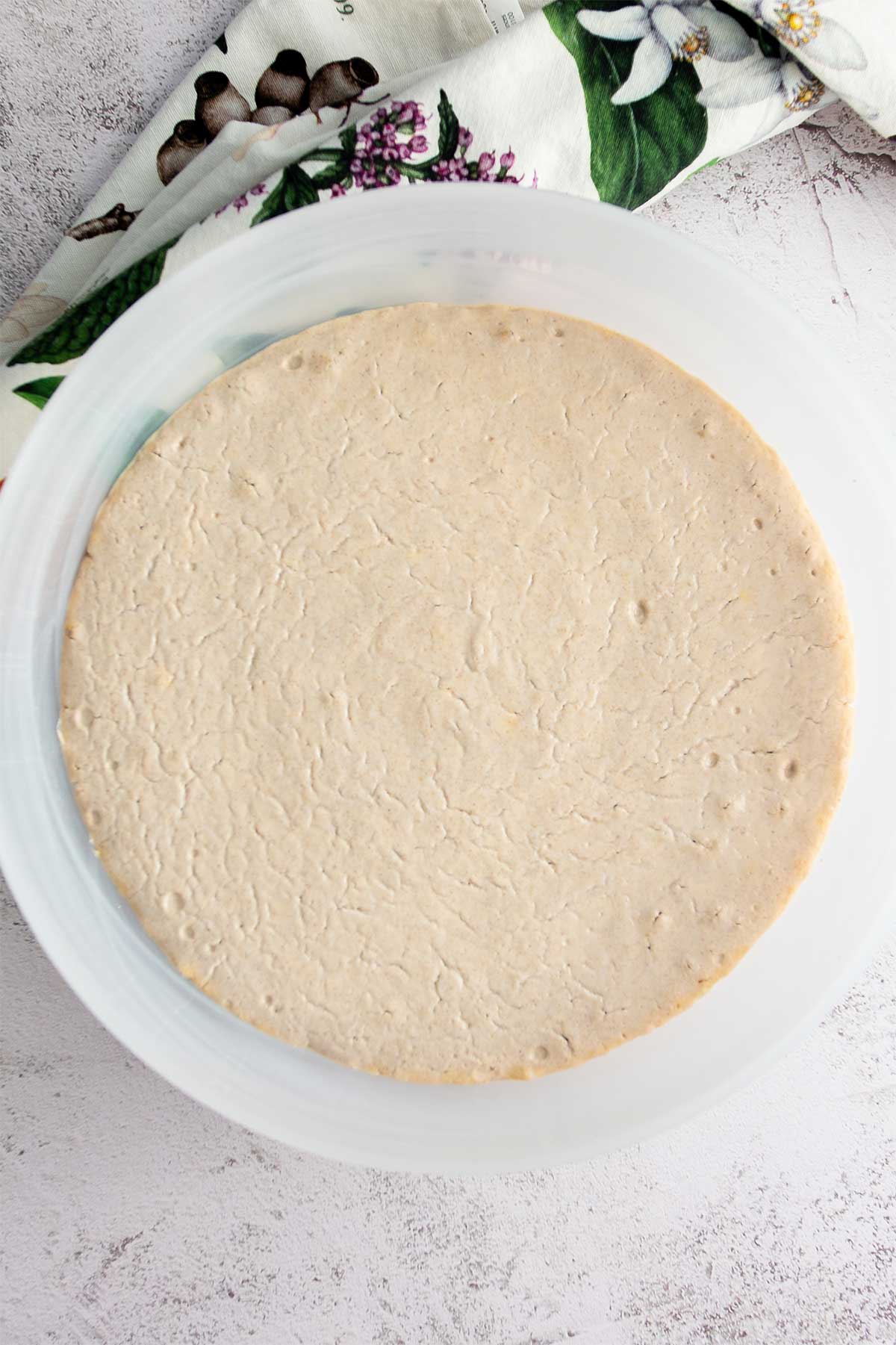

When you’re ready to bake, preheat your oven to 350°F. Line a loaf pan with baking paper and pour the fermented buckwheat dough into the pan. If you’d like, sprinkle the top with 2 tsp of poppy and sesame seeds (or whichever toppings you’d like).


Bake the bread in the preheated oven for 90 minutes. The bread should be golden brown and firm to the touch.


Allow the bread to cool down before slicing. This makes it easier to cut and improves the texture. Enjoy your homemade, nourishing, gluten-free buckwheat bread!


How Long to Ferment Your Buckwheat Bread Based on Your Current Climate
🌨️ Colder (Winter)
Indoor temperature range: ~70°F (20°C)
Soak: 6–7 hours
Fermentation time: Up to 24 hours
Note: If the temperature is lower than 70°F (20°C), place the bread in a warm spot or near a gentle heat source to help it ferment.
☀️ Warm (Summer)
Indoor temperature range: 75–85°F (25–30°C)
Soak: 6–7 hours
Fermentation time: Around 12 hours
Note: A warm environment speeds up fermentation, so check the texture after 10–12 hours.
🔥 Very Hot
Indoor temperature range: Above 85°F (30°C)
Soak: 6 hours
Fermentation time: As little as 6 hours
Note: The hotter it is, the less time needed. In extreme heat, soak the buckwheat in the fridge for 6 hours only.

1-Ingredient Buckwheat Bread (Nourishing and GF)
Equipment
Ingredients
- 17.6 oz (500 g) hulled buckwheat kernels (2.6 cups) - MUST be hulled, raw buckwheat kernels/groats for this recipe to work
- 6.8 fl oz (200 ml) water (0.9 cups)
- ¼ tsp (1.5 g) sea salt flakes
- 2 tsp (4 g) poppy and sesame seeds - optional
Instructions
- Rinse the hulled raw buckwheat kernels under cold water until the water runs clear. This ensures that any dust or impurities are removed.
- Transfer the rinsed buckwheat to a large bowl. Cover the kernels with a large volume of cold water, ensuring they are fully submerged. Cover the bowl with a clean cloth and let it sit for 6 to 7 hours.
- Once soaked, drain the water, but do not rinse the buckwheat kernels. Transfer them to a blender with 6.8 fl oz (0.9 cups/200 ml) water and the salt. Blend, starting at low speed and slowly increasing until you get a very smooth texture without any bits and pieces of buckwheat remaining.
- Pour the blended buckwheat batter back into the bowl. Cover it again and let it sit at room temperature for 12 to 24 hours (please see notes to determine how long you should leave it to ferment based on your climate). Once fermented, you will notice a very slight rise, and the mixture should be slightly bubbly inside.
- When you're ready to bake, preheat your oven to 350 °F. While the oven is heating, prepare a loaf pan by lining it with baking paper.
- Pour the fermented buckwheat dough into the prepared loaf pan. If using, sprinkle the top with poppy and sesame seeds.
- Bake the bread in the preheated oven for 90 minutes.
- Remove the bread from the loaf pan and let it cool completely before slicing. This is important to get the best texture. Now, enjoy your homemade, healthy buckwheat bread!
Video
FAQ
This depends on your location and current temperature, as fermentation is temperature-dependent. Colder climates will need a longer fermentation, and it can be shortened as the temperatures rise during the year, as the heat accelerates fermentation.
For colder climates (winter, with an indoor temperature of approximately 70°F (20°C)), ferment for 24 hours. If your indoor temperature is below 70°F (20°C), you can try leaving the batter in the warmest place in your house to give it the best chance of fermenting.
For warmer climates (summer with an indoor temperature between 75 – 85°F (25 – 30°C), I’d recommend starting with 12 hours of fermentation. We have tested this recipe in both summer and winter in Sydney Australia, which remains a pretty temperate climate. Depending on where you are in the world there might be a little bit of experimenting to figure out the perfect timing, but I promise it’s well worth it!
Some people from our IG community in more exotic locations with hotter and more humid climates have reported good results with as little as 6 hours of fermentation. If this is the case for you, start with 6 hours of fermentation and monitor the dough to avoid over-fermenting. The dough will have a slightly raised appearance and be a little bubbly inside when ready to eat.
Yes, fermentation does have a specific smell, which will be reduced when baking. Over soaking the buckwhat will result in a unpleasant smell, so keep it to 6-7 hours soaking time on the kitchen counter or in the fridge for extremely hot and humid climate.
Yes, it’s completely gluten-free.
This recipe only works with HULLED, NON-ROASTED buckwheat groats.
Unfortunately, it won’t work for this recipe.
It stays fresh for up to 3 days in a sealed container or wrapped in a kitchen cloth. I like to slice half straight away and freeze it to make the most of it.
Yes, slice and freeze for up to a month.
While the base recipe only requires one ingredient and cannot be swapped, you can certainly add other ingredients to customize the bread to your liking. Consider adding seeds, nuts, dried fruits such as dates, or spices for additional flavor and texture. I love a mix of black olives (pitted!), rosemary, and walnuts! Just remember to add these extras after the fermentation process and before baking. I however recommend tasting the bread without any ad-ons first, to make sure you have the perfect fermentation time, and know what to expect in terms of taste and consistency. Then, feel free to experiment with these additional ingredients to achieve your desired balance of flavor and texture.
You can; it will still work, but I find it provides a much-needed touch to the flavor of the bread.
It has a very slight rise – it’s quite different from yeast fermentation. Don’t worry if it looks like your dough hasn’t risen much – it will still work.
If that’s the case, I would recommend rinsing the buckwheat as it might develop a bit of a smell otherwise. It’s still fine to consume. We recommend not to rinse in our recipe, as when we tested it, we got a slightly nicer texture once baked, but it still worked when rinsed.
They are fine to leave on the counter. However, if it’s too hot or humid where you are, you can place them in the fridge. Leave out of the fridge for the fermentation part.
If you slice it before it cools down, it will just have a mushier texture.
If your indoor temperature is lower than the one we have mentioned, it might need to be fermented longer. Use filtered water if the water in your area contains a lot of chlorine, as this will negatively impact fermentation. Someone in the community also mentioned fermenting the dough directly in the loaf pan as a tip to get it to rise even more.


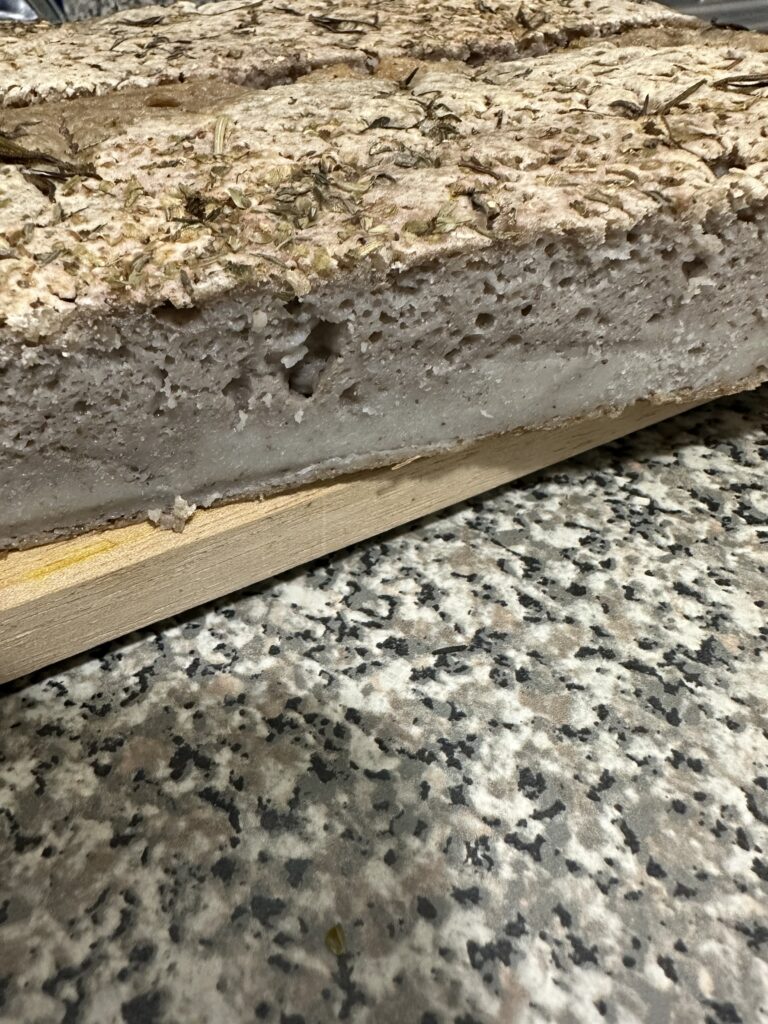
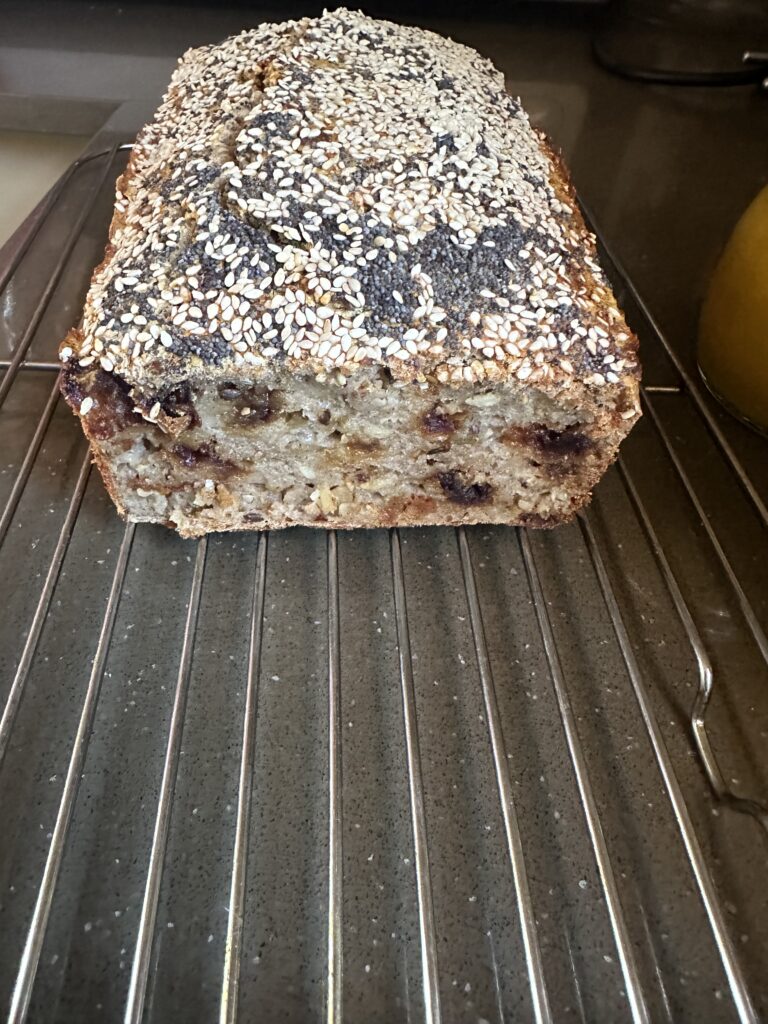








Wow! I rarely leave comments on websites but I had to for this one. This one-ingredient gf bread recipe is genius. It turned out perfectly for me. I soaked the buckwheat for 6 hrs and fermented the dough for 14 hrs on the kitchen counter overnight (it’s approx 67 degrees in my house). It turned out perfectly!
Aww thank you Lauren! Thank you for taking the time to comment and for sharing your process! It’s so kind and helpful to others, I really appreciate it! 💚😊
Thank you for sharing this recipe. I live in a very warm tropical climate so the fermentation took 10- hours. It came out perfect. I can finally enjoy healthy homemade bread. :))
Thank you so much for sharing your experience, it’s very helpful for everyone 🙂 I’m so happy you’re enjoying the bread!
What are the visual cues to proper fermentation? What is your ambient temp during winter and summer?
The dough does not rise much, so there will be a little bit of trying involved 🙂 I’m in Sydney Australia, so it does not get too cold. If you check the F&Q I’ve added some pointers about temperatures 🙂
Oh my word. I really wanted this to work. Like someone else, there was a “fragrance” issue that is still lingering after 24 hours, and living in a tropical region this may have something to do with it. However what I really wanted to say was that recipes have to be tested again and again, and there are too many try this or try that remedies being suggested here. Being unsure about weather, water or to wash or not to wash, this was an expensive exercise and I’m very sorry that it didn’t work. My house smells like a herd of 3000 cattle vomited silage all over it.
Hi India,
Thank you for your comment. I’m sorry the recipe didn’t work for you. It’s been successful for many, as seen on my Instagram bread highlight. I’ve personally made it about 50 times by now.
In tropical climates, reducing fermentation time is key due to quicker fermentation. I’ve tested this recipe in various conditions in my location, but it’s challenging to account for all environments, and seasons around the world.
Regarding buckwheat, it’s affordable here but I understand it can be costly elsewhere.
Your feedback is valuable, and I hope our future recipes better suit your needs.
Cette recette est fabuleuse ! ce pain est croustillant et moelleux à souhait !je vais en faire un par semaine et autour de moi tout le monde l a apprécié 😁
genial, ça me fait super plaisir 🤍
Hi, just trying the recipe, it’s in the oven. I opted to make a shorter fermentation, here is a bit warm (13h). The dough developed an upperlayer of pink colour, I scraped it off carefully and used the dough anyway… It doesn’t smell bad so let’s see how this turns out 🤞
Hi Sarah,
Thanks for the recipe!
How long should you blend it for i.e. what consistency should it become?
Blend until smooth and no more little grainy part. You can see the exact consistency in the video 🙂 I like to start the blender slow and then ramp it up, can take a bit more than a minute with my high speed blender. Hope this helps 🥰
Need some tips on blending the buckwheat. It smells great but the blending process is not going so well. The groats filled it to the top so my Blendtec blender was overheating. I removed half of the batch, added more water and blended in two parts. Is 200 ml water correct?
Hey Pam, sorry I’m not familiar with Blendtec, but sounds like you’re right and might need to do it in 2 batches. 200ml is correct, although you might get away with adding a bit more. I like to start slow to get it going, and then slowly ramp it up to high speed. Did yours turn out okay with the extra water?
Is slime ok in buckweat after soaking? Left for almost 24 h. Or should I start over?
I would recommend rinsing it thoroughly if you’ve left it soaking too long. It will slightly affect the texture but should still be fine. For next time I recommend soaking it overnight for 8 to 10 hours max x
Heya
Can we ferment for more than 24 hours?
Thanks a lot
I have not tried it, let us know if you do 🙂
The recipe stated preheat the oven to 350F but what about the baking temperature? What temperature should we set to the oven for baking?
Hey Rachel, the baking temperature will be the same, 350F 🙂
Hi Sarah !
Love your recipes!
I did this bread twice an I got 2 different results. The first time it was perfect and fluffy ! Thank you ! The second time the bread didn’t rise and it looks kind of wet . Has it ever happened to you ?
( I live in nyc and the room temperature is cool enough)
Thanks so much ,xx
Hey Kyriaki, so happy you liked the recipe! Sorry I’m not quite sure what happened there, I’d recommend baking it in the middle of the oven (without any large tray or other food in there) to make sure the heat is distributed equally 🙂
Was a bit skeptical, but it worked. Had to put the oven at very low temp, so that the dough was around 95F, and in 10 hours the size doubled.
Where do you buy unhulled buckwheat from? I can’t find it anywhere?
Blessings,
Alicia
Hey Alicia, if you’re in Australia it’s available at Coles and Woolworth in the health section. Harris Farms also has it. I make it weekly now so I get 5 kilos bag from honest to goodness (here is the link: https://www.amazon.com.au/Honest-Goodness-Organic-Buckwheat-Hulled/dp/B07GZQPDG1/ref=sr_1_6?keywords=buckwheat&qid=1695082942&sr=8-6 ) hope this helps!
Can I use roasted buckwheat for this recipe?
Unfortunately, only non roasted hulled buckwheat will work for this one
Whoa!!! Blown away by the taste of this bread. I love the crunchy crusty that’s slightly chewy. Totally reminds me of sourdough. I tried an all flax seed bread recipe and my body couldn’t tolerate that much flax – not to mention the taste was NOT pleasant lol! I am sooooooooo happy to find this recipe. What a treasure. Thank you!!
I noticed your raised quite a bit more than mine. I know it all depends on the temp of your house but curious which water you used. Tap, filtered, etc.
Hey Hope, I’m so happy to hear you loved it! I’ve always used tap water so far, for reference I am in Sydney, and I know it can vary a lot depending on the location, so might be worth trying mineral or filtered water. Would love to know how you go if you try it 🙂
First time making this and it was so easy! I discovered you on instagram and I’m so glad I did, I love your content/recipes. So thrilled with how it turned out and it’s delicious.
Oh you’re so kind, thank you so much 🥰 I’m so happy to hear you’re enjoying the bread!
Once the dough is fermented can you use it for pancakes? Adding some apple sauce to the batter maybe?
I have not tried but someone in our Instagram community mentioned making pancakes from it, so you might be onto something! Please let us know if you give it a go 🙂
We’ve been making this almost every single week! Love it so much thank you x
Oh that makes me so happy to hear! Thank you for letting me know and I’m so glad you’re enjoying it!
I tried to make this but I think I live in too humid an environment (at the equator) to let it sit that long to ferment. It kind of exploded and smelled TERRIBLE and made my entire kitchen smell rotten. How long do you think I should let it sit next time when I try to make it? Could I bake it sooner without letting it ferment? Gluten free bread is very expensive by me and I’d love to be able to use this recipe somehow! I’m also new to bread making and have no idea how to proceed. Thank you so much for the help!
Oh no, that’s not great, I’m sorry to hear that! It’s still winter for me so I haven’t experimented with warmer weather yet (but will update as soon as I do!). Here is what I have gathered from our instagram community in warmer places.
Soak the buckwheat for 5 hours, then let it ferment for 6 to 12 hours. Some people have reported good results with as little as 6 hours of fermentation in warmer countries. Maybe you can check at the 6 hour mark and decide if you’d like to cook it or give it a few extra hours? If the smell is an issue, you can also rinse the buckwheat after the soaking phase. It slightly impacts the texture but it still works fine and should take care of the smell.
Would love to know how you go if you give it another try as it’s became a weekly staple for us and so many others around the world! I promise it’s well worth the effort 😊
I am in love with your buckwheat bread. Thank you so much for an amazing recipe. I added a few extras, dates etc & it’s absolutely yummy.
Thank you so much for sharing and I love that you’ve experimented with dates, etc. that’s fantastic! Will have to give that a go 🥰🤍
Thank you for this recipe ,
Made one today, added some dates to it , OMG 😲 so delicious 😋 😍 💕 thanks
again, monique
I’m so happy you like it! I’ll have to try with dates, sounds delicious x